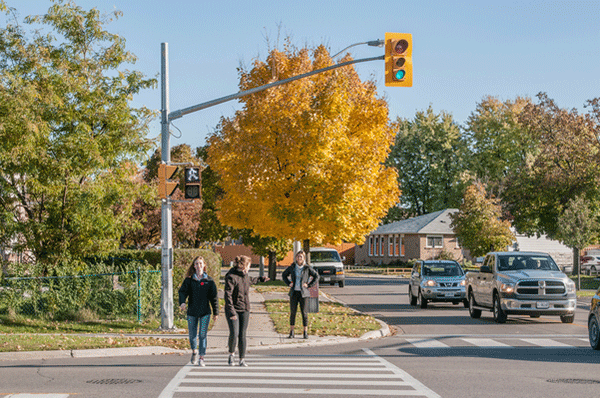Bringing Health and Health Equity into Natural Heritage in Peel Region

THE PROJECT
The public health unit in Peel Region has collaborated across sectors to bring climate, health and health equity considerations into natural heritage plans and tools such as the Tree Planting Prioritization Tool.
BACKGROUND
Located to the west of Toronto, the Regional Municipality of Peel is a rapidly growing upper-tier municipality. With a population of 1.4 million people, Peel Region includes the cities of Mississauga and Brampton and the town of Caledon. Peel Health, the agency responsible for community health, is embedded as a department within Peel Region and its Board of Health is Regional Council.
For over 20 years, Peel Health has been actively engaged in land use and transportation planning processes across the region with the goal of creating communities that support health, health equity and healthy living. The department’s inter-sectoral work focuses on policies and plans that influence physical activity, healthy eating, air quality and climate change. Policies and plans related to natural heritage such as the tree canopy, parks and greenspace in the Region advance many of these priorities.
THE PROCESS
In 2012, in response to a recommendation in Peel Region’s Climate Change Strategy, Peel Health prepared a Climate Change Vulnerability Assessment. This report identified relevant climate-related vulnerability indicators of exposure, sensitivity, and adaptive capacity in the Region. It has since been used to inform other Peel-specific vulnerability assessments related to water/wastewater, natural heritage, agriculture, and two community-specific vulnerability assessments. Prior to the COVID-19 pandemic, Peel Health was working to update this assessment.
“This first assessment report identified extreme heat, insect-borne diseases such as Lyme Disease and West Nile Virus, extreme weather and natural disasters/hazards, contamination of food and water, and poor air quality as the climate-related health risks we could expect in Peel,” said Kiran Ghai, Advisor in the Health Protection division at Peel Health. “The health risks presented by extreme heat led us into discussions about natural heritage policies related to the urban forest, tree planting, and parks in Peel.”
Since 2015, climate change has been a strategic priority for the regional government. In 2019, Peel Health published The Changing Health Landscape in Peel, which is a comprehensive health status report prepared for Peel’s population for the period 2009-2019. The report includes several environmental and health indicators, such as hospital admissions from extreme weather and the number of cases of insect-borne diseases, which can be used to monitor the impact of climate change on the public’s health in the Region. As a result of these inputs, Peel Health identified “reducing the health-related impacts of climate change” as a 10-year strategic priority.
“There is better data available to us today on the climate-related impacts and health risks that can be expected in this Region,” explained Ghai. “We plan to use the findings in these new reports to strengthen and fine-tune regional and local policies and plans. We want to use them to support the region’s adaptation activities, increase the community’s resiliency to climate-related impacts, and promote population health and health equity as much as possible.”
Peel Health staff are also members of the Region’s Urban Forest Working Group and Climate Change Steering Committee along with staff from other departments, representatives from the three local municipalities, and representatives from the two conservation authorities that operate in the region. Peel Health staff have had the opportunity to influence natural heritage issues raised in the Region’s Official Plan and the official plans and climate change adaptation plans of the three local municipalities.
“In all of these processes, we have brought forward the health evidence that supports the need to expand and protect our tree canopies, parks, and greenspace” explained Ghai. “There is a growing body of health evidence that suggests that trees, parks and greenspace can improve mental health, foster physical activity and social cohesion, reduce temperatures during extreme heat, and improve air quality. We wanted to ensure that these health co-benefits were included in the rationale in natural heritage strategies and plans.”

When it was decided that a tool was needed to help prioritize tree planting across the region, Peel Region’s Planning Department convened a Technical Advisory Committee to help guide its development. Staff from Peel Health were included along with representatives from the conservation authorities and local municipalities. Health Canada also provided technical and financial support for this process.
A systematic review was conducted on the various benefits associated with trees. The findings of the review and feedback from the committee were used by the Project Team to select eight overall benefits, categorize them under one of three sustainability themes – environmental, economic and social – and identify the data sources and weighting for each one. The eight benefits include:
- Mitigating Air Pollution (Environmental)
- Mitigating Urban Heat Island Effects (Environmental)
- Contributing to the Management of Surface Water Quantity and Quality (Environmental)
- Maintaining and Enhancing Natural Heritage (Environmental)
- Enhancing Economic Value (Economic)
- Providing Direct Cost Savings (Economic)
- Supporting Improved Physical Health and Emotional Well-being (Social)
- Strengthening Communities and Enhancing Social Equity (Social)
“My role was to bring the health and health equity lens to the table,” offered Ghai. “When you look at the list of benefits, it is clear that at almost all of them relate to the protection or promotion of public health.”
The benefits, data sources and weighting were used to create the Region’s Tree Planting Prioritization Tool which is an interactive map. The partners can combine different layers of data for each of the eight benefits to identify the neighbourhoods that should be prioritized for tree planting.
“We know that some populations, such as older people and people with pre-existing health conditions, can be more sensitive to climate-related impacts such as extreme heat. We also know that some populations, such as those who live on low incomes, are more likely to be exposed to higher temperatures because they may not have access to air conditioning or cool spaces. In addition, a number of studies suggest that vulnerable populations are more likely to live in neighbourhoods that have fewer trees and less greenspace, which can have a cooling effect on air temperatures and a positive impact on health,” explains Ghai. “The Tree Planting Prioritization Tool can be used to identify the neighbourhoods that would benefit most, from a health and health equity perspective, from improvements in the local tree canopy.”
THE OUTCOMES
Since beginning its work on natural heritage, Peel Health has been instrumental in ensuring that the health co-benefits and health-related goals related to trees, parks and greenspace are incorporated into:
- The Region’s Official Plan, Urban Forest Strategy, and Tree Planting Prioritization Tool; and
- Official plans and climate change plans of the three local municipalities.
Peel Health also participated in the development of a case study quantifying the Health Return on Investments in Greenspace: Increasing Tree Canopy in the City of Brampton. Health benefits included a reduction in exposure to air pollution and extreme heat as well as benefits to physical and mental health. The case study estimated that the health benefits of more canopy cover equate to $2,437,363 in a scenario where canopy cover is increased by 50% and $3,175,826 when there is an 80% increase in canopy cover.

LESSONS LEARNED
Twenty years of inter-sectoral collaboration has taught Peel Health staff that:
- Partnerships are incredibly important. By developing strong working relationships with staff in other departments, the local municipalities, and conservation authorities, public health is informed about opportunities and included in processes that allow staff to weave health goals, evidence and considerations into policies and plans that influence population health, health equity, and climate change.
- Public health has health expertise, credibility and evidence that can be used to support inter-sectoral partners with their goals.
- Public health needs to identify the policies and investments that are needed to address population health, health equity, and climate change, and trust their inter-sectoral partners to identify the processes and steps that public health must engage in to achieve their goals.
Prepared by Kim Perrotta, MHSc, Executive Director, CHASE
Last modified: June 15, 2023
